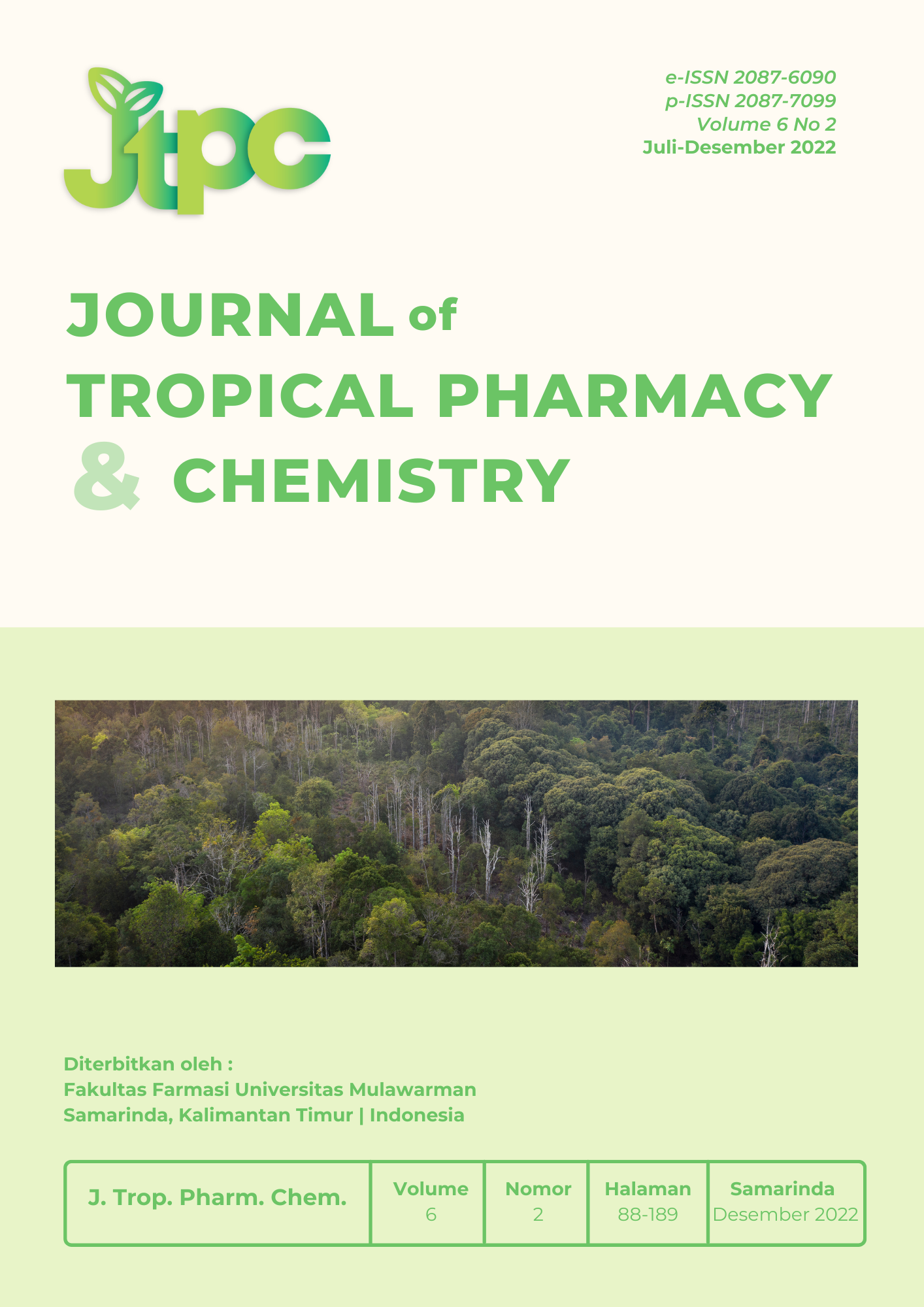Genistein Content and Tyrosinase Inhibitory Activity of Edamame (Glycine max) Extracts
DOI:
https://doi.org/10.30872/j.trop.pharm.chem.v6i2.243Keywords:
Edamame, Glycine max, genistein, tyrosinase inhibitorAbstract
The study aimed to determine genistein content and tyrosinase inhibition activity of 70% ethanolic and ethyl acetate extracts of edamame (Glycine max) with an extraction time of 15, 30, and 60 minutes. Extraction was performed using the ultrasonication method. Determination of genistein content was carried out using TLC-densitometry. Furthermore, all samples were tested for their tyrosinase inhibition activity using the spectrophotometric assay. Ethyl acetate extract with 60 min of extraction time exhibited the highest extraction yield (6.414% w/w), the highest genistein content (0.169 ± 0.007% w/w), and the highest tyrosinase inhibition activity (IC50 = 72.420 ± 0.550 µg/mL). It was known that the genistein content of 70% ethanolic and ethyl acetate extracts affected tyrosinase inhibition activity with correlation coefficient (r) values of 0.9973 and 0.9826, respectively. G. max was suggested as a tyrosinase inhibitor agent from natural sources for skin whitening product development due to its isoflavones content, mainly genistein.
Downloads
References
Del Bino, S., Duval, C., Bernerd, F. 2018. Clinical and Biological Characterization of Skin Pigmentation Diversity and Its Consequences on UV Impact. Int. J. Mol. Sci. 19:2668.
Hsu, J.-Y., Lin, H.-H., Li, T.-S., Tseng, C.-Y., Wong, Y., Chen, J.-H. 2020. Anti-Melanogenesis Effects of Lotus Seedpod In Vitro and In Vivo. Nutrients. 12:3535.
Vashi, N. A., Kundu, R. V. 2013. Facial hyperpigmentation: causes and treatment. Br. J. Dermatol. 169:41–56.
Choi, M.-H., Shin, H.-J. 2016. Anti-Melanogenesis Effect of Quercetin. Cosmetics. 3:18.
Kamakshi, R. Fairness via formulations: a review of cosmetic skin-lightening ingredients. J. Cosmet. Sci. 63:43–54.
Yatsu, F. K. J., Koester, L. S., Bassani, V. L. 2016. Isoflavone-aglycone fraction from Glycine max: a promising raw material for isoflavone-based pharmaceutical or nutraceutical products. Rev. Bras. Farmacogn. 26:259–267.
K?ížová, L., Dadáková, K., Kašparovská, J., Kašparovský, T. 2019. Isoflavones. Molecules. 24:1076.
Chang, T.-S., Ding, H.-Y., Lin, H.-C. 2005. Identifying 6,7,4?-Trihydroxyisoflavone as a Potent Tyrosinase Inhibitor. Biosci. Biotechnol. Biochem. 69:1999–2001.
Hassan, S. M. 2013. Soybean, Nutrition and Health. In Soybean - Bio-Active Compounds, ed. El-Shemy, H. A. InTech. doi:10.5772/54545.
Chae, G.-Y., Ha, B.-J. 2011. The Comparative Evaluation of Fermented and Non-fermented Soybean Extract on Antioxidation and Whitening. Toxicol. Res. 27:205–209.
Wijngaard, H. H., Brunton, N. 2010. The optimisation of solid–liquid extraction of antioxidants from apple pomace by response surface methodology. J. Food Eng. 96:134–140.
Borges, G. D. S. C., Vieira, F. G. K., Copetti, C., Gonzaga, L. V., Fett, R. 2011. Optimization of the extraction of flavanols and anthocyanins from the fruit pulp of Euterpe edulis using the response surface methodology. Food Res. Int. 44:708–715.
Anuar, N., Mohd Adnan, A. F., Saat, N., Aziz, N., Mat Taha, R. 2013. Optimization of Extraction Parameters by Using Response Surface Methodology, Purification, and Identification of Anthocyanin Pigments in Melastoma malabathricum Fruit. Sci. World J. 2013:1–10.
Batubara, I., Darusman, L. K., Mitsunaga, T., Rahminiwat, M., Djauhari, E. 2010. Potency of Indonesian Medicinal Plants as Tyrosinase Inhibitor and Antioxidant Agent. J. Biol. Sci. 10:138–144.
Mohamad, M., Ali, M. W., Ripin, A., Ahmad, A. 2013. Effect of Extraction Process Parameters on the Yield of Bioactive Compounds from the Roots of Eurycoma Longifolia. J. Teknol. 60.
Yuan, D., Chen, Y., Bai, X., Pan, Y., Kano, Y. 2006. TLC and HPLC Analysis of Soy Isoflavones in Semen Sojae Praeparatum. Asian J. Tradit. Med. 1:166–172.
Wulandari, L., Yuwono, M., Indrayanto, G. 2012. Densitometric determination of mebhydrolin napadisylate in tablets. J. Planar Chromatogr. – Mod. TLC. 25:60–64.
Yuliani, S. H., Gani, M. R., Istyastono, E. P., Riswanto, F. D. O. 2018. Optimization of genistein and daidzein extraction from a tempeh-fermented product of soybean. J. Pharm. Pharmacogn. Res. 6:231–241.
Xiao, Y., Ho, C.-T., Chen, Y., Wang, Y., Wei, Z., Dong, M., Huang, Q. 2020. Synthesis, Characterization, and Evaluation of Genistein-Loaded Zein/Carboxymethyl Chitosan Nanoparticles with Improved Water Dispersibility, Enhanced Antioxidant Activity, and Controlled Release Property. Foods. 9:1604.
Kusumawati, L. A. I., Dewi, E. N. A., Xenograf, O. C., Hidayat, M. A. 2015. Tyrosinase Inhibition Assay and Skin Whitening Cream Formulation of Edamame Extract (Glycine max). Int. J. Pharmacogn. Phytochem. Res. 7:1167–1171.
Curto, E. V, Kwong, C., Hermersdörfer, H., Glatt, H., Santis, C., Virador, V., Hearing, V. J., Dooley, T. P. 1999. Inhibitors of mammalian melanocyte tyrosinase: in vitro comparisons of alkyl esters of gentisic acid with other putative inhibitors. Biochem. Pharmacol. 57:663–672.
Gregorich, M., Strohmaier, S., Dunkler, D., Heinze, G. 2021. Regression with Highly Correlated Predictors: Variable Omission Is Not the Solution. Int. J. Environ. Res. Public Health. 18:4259.
Pyo, Y.-H., Jin, Y.-J. 2016. Monascus-mediated fermentation improves the nutricosmetic potentials of soybeans. Food Sci. Biotechnol. 25:883–891.
Sumardi, D., Pancoro, A., Yulia, E., Musfiroh, I., Prasetiyono, J., Karuniawan, A., Syamsudin, T. S. 2017. Potential of local black soybean as a source of the isoflavones daidzein and genistein. Int. Food Res. J. 24:2140–2145.
Downloads
Published
Issue
Section
License
Copyright (c) 2022 Indah Yulia Ningsih, Lisa Kusuma Wardhani, Annisa Ragdha Eka Nuryuanda, Endah Puspitasari, Mochammad Amrun Hidayat (Author)

This work is licensed under a Creative Commons Attribution-NonCommercial 4.0 International License.




